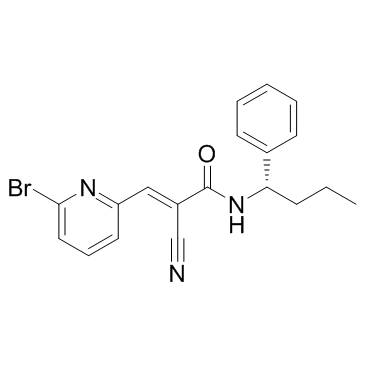Degrasyn(WP1130)
Modify Date: 2024-01-02 08:38:02

Degrasyn(WP1130) structure
|
Common Name | Degrasyn(WP1130) | ||
|---|---|---|---|---|
| CAS Number | 856243-80-6 | Molecular Weight | 384.270 | |
| Density | 1.4±0.1 g/cm3 | Boiling Point | 582.1±50.0 °C at 760 mmHg | |
| Molecular Formula | C19H18BrN3O | Melting Point | N/A | |
| MSDS | N/A | Flash Point | 305.9±30.1 °C | |
Use of Degrasyn(WP1130)Degrasyn (WP1130) is a cell-permeable deubiquitinase (DUB) inhibitor, directly inhibiting DUB activity of USP9x, USP5, USP14, and UCH37. Degrasyn has been shown to downregulate the antiapoptotic proteins Bcr-Abl and JAK2. |
| Name | (E)-3-(6-bromopyridin-2-yl)-2-cyano-N-[(1S)-1-phenylbutyl]prop-2-enamide |
|---|---|
| Synonym | More Synonyms |
| Description | Degrasyn (WP1130) is a cell-permeable deubiquitinase (DUB) inhibitor, directly inhibiting DUB activity of USP9x, USP5, USP14, and UCH37. Degrasyn has been shown to downregulate the antiapoptotic proteins Bcr-Abl and JAK2. |
|---|---|
| Related Catalog | |
| Target |
IC50: 1.8 μM (Bcr-Abl, in K562, BV-173 cells)[1] Deubiquitinase[2] |
| In Vitro | Degrasyn, a small molecule that specifically and rapidly down-regulates both wild-type and mutant Bcr/Abl protein without affecting bcr/abl gene expression in chronic myelogenous leukemia (CML) cells. Degrasyn is more effective in inducing apoptosis of myeloid and lymphoid tumor cells (IC50 0.5 to 2.5 μM) than normal CD34+ hematopoietic precursors, dermal fibroblasts, or endothelial cells (IC50 ~5 to 10 μM). Degrasyn reduces Bcr/Abl protein levels through a unique mechanism that is not affected by mutations that interfere with imatinib mesylate binding. Degrasyn inhibits phosphorylation of both the wild-type and the T315I mutant Bcr/Abl proteins, as demonstrated by the rapid disappearance (within 1 hour) of phosphotyrosyl-Bcr/Abl in both BV173 and BV173R cells. Degrasyn-induced down-regulation of Bcr/Abl is accompanied by apoptosis of CML cells[1]. Treatment with Degrasyn yields an anti-proliferative effect across all cell lines tested in a dose-dependent manner. Notably, treatment with Degrasyn results in marked anti-proliferative activity and morphological changes in NCH644 and NCH421K glioma stem-like cells. Treatment with Degrasyn results in a dose-dependent and probably compensatory increase of Mcl-1 mRNA levels after 6 h and only a minor decrease after 24 h. Similar findings are observed for Usp9X levels. These data suggest that Degrasyn down-regulates Mcl-1 and Usp9X through a post-transcriptional mechanism[2]. |
| In Vivo | Degrasyn suppresses the growth of K562 heterotransplanted tumors as well as both wild-type Bcr/Abl and T315I mutant Bcr/Abl-expressing BaF/3 cells transplanted into nude mice. To assess the possible therapeutic activity of Degrasyn against CML, nude mice received a subcutaneous transplant with K562 cells and are treated with 30 mg/kg Degrasyn every other day for 9 days after palpable tumor formation (10 days). This dose and schedule are well tolerated and effective in other tumor models. Antitumor activity is compared with that after daily Imatinib mesylate treatment (50 mg/kg). Nineteen days after tumor inoculation, tumors in the control group reached maximum allowable dimension, and the effect of therapy is assessed. Degrasyn treatment suppresses K562 tumor growth to an extent comparable to that observed in imatinib mesylate-treated animals, suggesting that Degrasyn is active in reducing the growth of established K562 tumors[1]. |
| Cell Assay | CML cells are seeded in 96-well plates (2×104 cells/well) and Degrasyn, Imatinib mesylate, or Dasatinib (0.08-10 μM) are added in a final volume of 100 μL medium. Plates are incubated at 37°C for 72 hours, after which 20 μL of MTT reagent (stock 5 mg/mL) is added, and the plates are incubated at 37°C for another 2 hours. Cells are lysed with 100 μL lysis buffer (20% SDS in 50% N, N-dimethylformamide adjusted to pH 4.7 with 80% acetic acid and 1 M hydrochloric acid; final concentration of acetic acid is 2.5% and hydrochloric acid is 2.5%) and incubated for 6 hours. The optical density of each sample at 570 nm is determined with a SPECTRA MAX M2 plate reader[1]. |
| Animal Admin | Mice[1] To assess activity against T315I Bcr/Abl mutant cells, BaF/3 cells transfected with wild-type Bcr/Abl or the T315I mutant are transplanted into female Swiss nude mice (5-6 weeks old). BaF/3wt cells are suspended (5×107 cells/mL) in RPMI medium, and 0.1 mL of this suspension is injected intravenously into 10 mice. The same procedure is used to inoculate 10 mice with BaF/3/T315I cells. One day after tumor cell inoculation, mice are randomly assigned to 1 of 3 groups: one group received Degrasyn (40 mg/kg, intraperitoneally) in 50 μL DMSO/PEG300 (vehicle) every other day (7 injections); another received imatinib mesylate (100 mg/kg, intraperitoneally) in vehicle daily (14 injections); and the third received vehicle alone daily (14 injections). Spleens from each mouse are harvested, photographed, and weighed 15 days after tumor cell inoculation. |
| References |
| Density | 1.4±0.1 g/cm3 |
|---|---|
| Boiling Point | 582.1±50.0 °C at 760 mmHg |
| Molecular Formula | C19H18BrN3O |
| Molecular Weight | 384.270 |
| Flash Point | 305.9±30.1 °C |
| Exact Mass | 383.063324 |
| PSA | 69.27000 |
| LogP | 4.01 |
| Vapour Pressure | 0.0±1.6 mmHg at 25°C |
| Index of Refraction | 1.617 |
| Storage condition | -20℃ |
| QCR-21 |
| WP1130 |
| (2E)-3-(6-Bromo-2-pyridinyl)-2-cyano-N-[(1S)-1-phenylbutyl]acrylamide |
| MFCD18839228 |
| CS-0483 |
| WP1130-Adooq Bioscience |
| 2-Propenamide, 3-(6-bromo-2-pyridinyl)-2-cyano-N-[(1S)-1-phenylbutyl]-, (2E)- |
| Degrasyn |